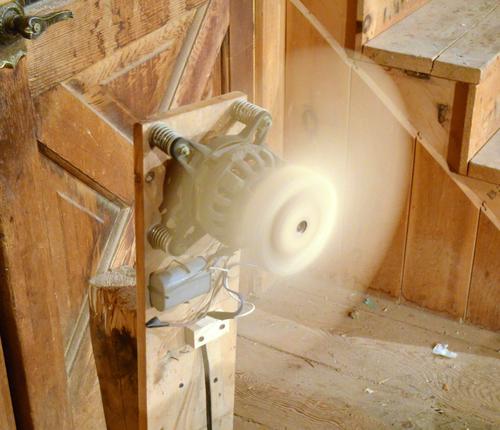 I was questioning whether it was worth building this box fan as I built it, but
it was a quick project, and it served a need.
I was questioning whether it was worth building this box fan as I built it, but
it was a quick project, and it served a need.
 I was questioning whether it was worth building this box fan as I built it, but
it was a quick project, and it served a need.
I was questioning whether it was worth building this box fan as I built it, but
it was a quick project, and it served a need.
I was dusting out my dad's workshop with an air compressor. I needed a fan to circulate outside air through the shop to get the dust out before it settled again.
As a teenager, I had experimented with making a simple wooden fan blade which I attached to a laundry spinner motor. This kicked up quite a wind, more so than the usual oscillating fan or box fan.
Looking for it in the attic, I found my experiment, just as I had left it 25 years earlier. So I used that for a while, but then figured more air flow would be even better.
There was another motor like that in the attic, so I figured I should use that to build another fan, this one with a box around it to make it slightly safer. The rational thing would have been to just buy a fan. They really don't cost much. But it would have meant making a trip to town. Besides, with a bigger 1700 RPM motor instead of the usual 1100 RPM motor in a box fan, the homemade fan would be more powerful.
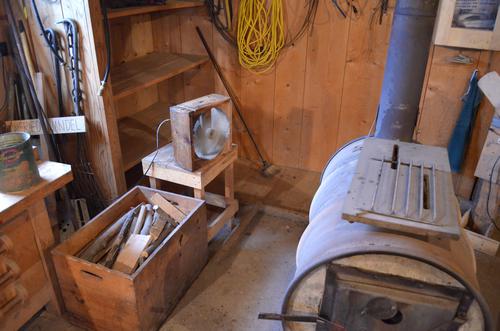 My dad had also been using another small box fan I built in the 80s. I
made this one to fit in my bedroom to blow cool air in. My dad picked it out of
the attic and used it to blow air at the workshop wood stove. This helped get
more heat out of that stove and spread it around the shop. It probably saved a fair
amount of firewood.
My dad had also been using another small box fan I built in the 80s. I
made this one to fit in my bedroom to blow cool air in. My dad picked it out of
the attic and used it to blow air at the workshop wood stove. This helped get
more heat out of that stove and spread it around the shop. It probably saved a fair
amount of firewood.
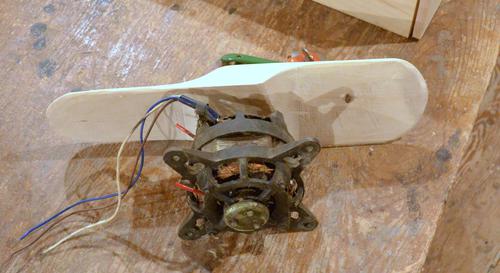 Like I did 25 years ago, I made a fan blade out of pine by cutting away at it at
an angle with a bandsaw, then smoothing and balancing
it with a spokeshave.
Like I did 25 years ago, I made a fan blade out of pine by cutting away at it at
an angle with a bandsaw, then smoothing and balancing
it with a spokeshave.
I drilled a 5/8" (16 mm) hole, and rammed it onto the 17 mm shaft of the motor. This makes for a very secure mount, but makes it just about impossible to get it off again without destroying the blade.
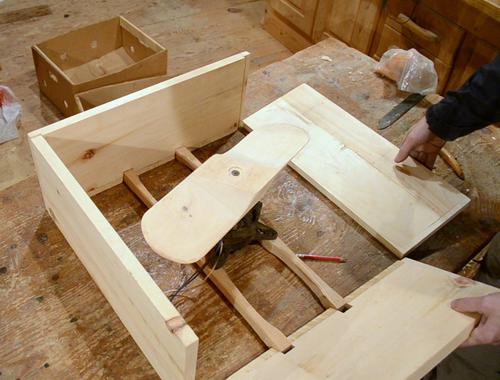 The enclosure is four boards, rabbet joined at the corners, with two hardwood rods
that the motor mounts to.
The enclosure is four boards, rabbet joined at the corners, with two hardwood rods
that the motor mounts to.
I would have box joined the corners, but this was in my dad's shop, so I didn't have my fancy box joint jig.
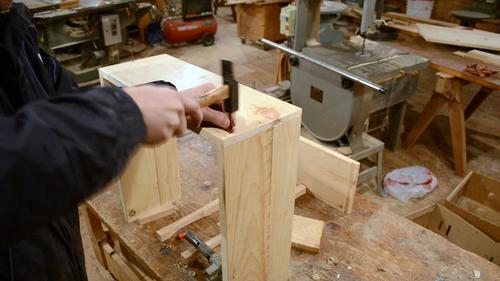 The corners are nailed and glued. Though, at about 10 degrees Celsius, it was too
cold for the glue to set properly. White glue, when it's too cold dries
to a brittle chalky white.
The corners are nailed and glued. Though, at about 10 degrees Celsius, it was too
cold for the glue to set properly. White glue, when it's too cold dries
to a brittle chalky white.
The nails I used were rusty ones. I nearly threw out a can of old nails on my dad's workbench when I cleaned up the shop, but it turns out, those were the only nails of the right size in the shop. I guess that's why they were on the workbench!
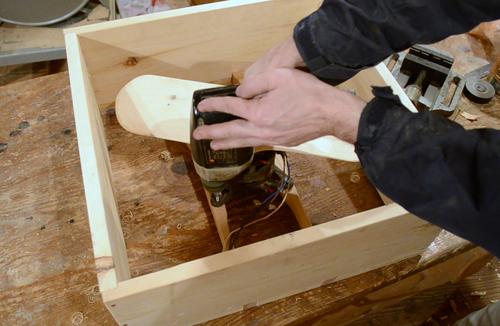 Screwing the motor onto the hardwood rods, using an old drill.
Screwing the motor onto the hardwood rods, using an old drill.
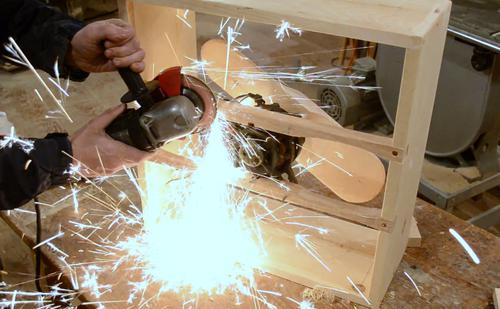 The screws I used were a bit too long (couldn't find the right kind of screw
my dad's shop), so they stuck out the back. I cut them off with an angle grinder.
The screws I used were a bit too long (couldn't find the right kind of screw
my dad's shop), so they stuck out the back. I cut them off with an angle grinder.
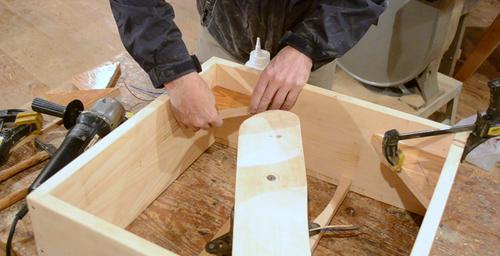 I added some plywood triangles to the corners of the box. These help
to keep the box square, and also prevent air from flowing backwards through
the box in the corners.
I added some plywood triangles to the corners of the box. These help
to keep the box square, and also prevent air from flowing backwards through
the box in the corners.
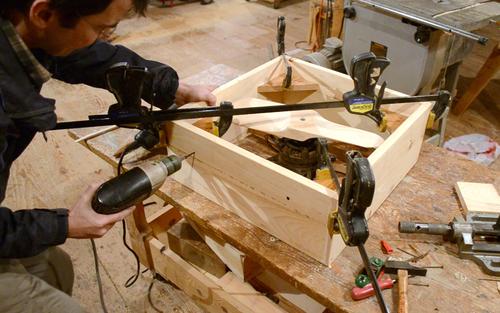 But once again, it was too cold for the glue to set properly, so I added some
screws to the corners for good measure.
But once again, it was too cold for the glue to set properly, so I added some
screws to the corners for good measure.
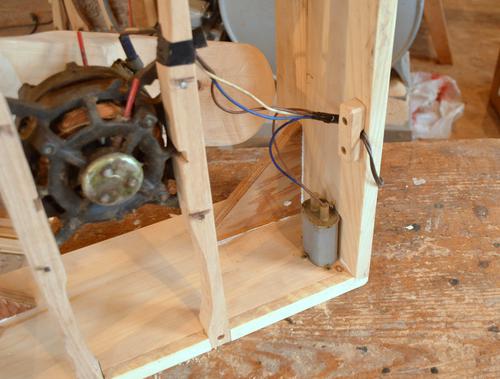 The motor is a split phase (capacitor run) motor. I mounted the 15 microfarad run
capacitor in the corner, held in place by a few screws. A wooden block
clamps the power cord as a strain relief. No on-off switch.
Plugging it in will have to do.
The motor is a split phase (capacitor run) motor. I mounted the 15 microfarad run
capacitor in the corner, held in place by a few screws. A wooden block
clamps the power cord as a strain relief. No on-off switch.
Plugging it in will have to do.
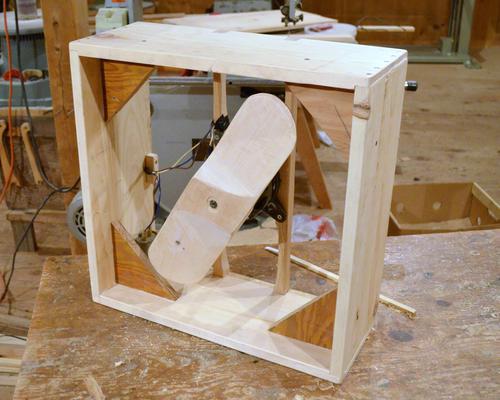 Finished fan. If this had been in my shop, I would have put a few coats of varnish on it
to keep it looking nice, but no water based varnish in this shop, and the oil based stuff
takes far too long.
Finished fan. If this had been in my shop, I would have put a few coats of varnish on it
to keep it looking nice, but no water based varnish in this shop, and the oil based stuff
takes far too long.
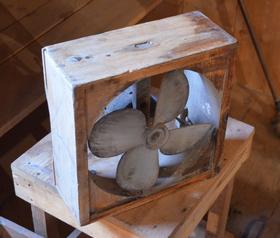
Untreated wood can get quite dirty. The small box fan on the right had gotten quite dirty after having been used to blow air past the stove. Even after trying to clean the crud off it, it still looked dirty.
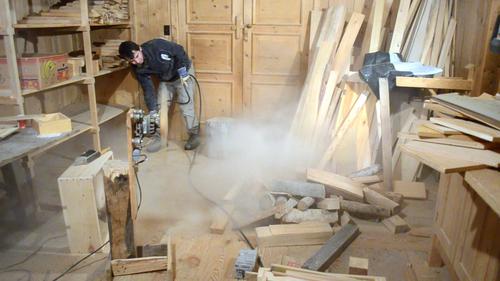 New box fan, plus the older fan in use dusting out the shop. I was cleaning off the
shelf full of off-cuts and such. Everything was coated with a 3 mm layer of very fine dust.
Most effective method was to throw everything in a pile, with the fans blowing the dust out the door.
Just throwing it loosened most of the dust off the wood. after that, I hit it with the air
compressor to get the rest of the dust off.
New box fan, plus the older fan in use dusting out the shop. I was cleaning off the
shelf full of off-cuts and such. Everything was coated with a 3 mm layer of very fine dust.
Most effective method was to throw everything in a pile, with the fans blowing the dust out the door.
Just throwing it loosened most of the dust off the wood. after that, I hit it with the air
compressor to get the rest of the dust off.
Update 2020:
If I had built a fan like this one, I wouldn't have needed an air compressor to dust out the shop!
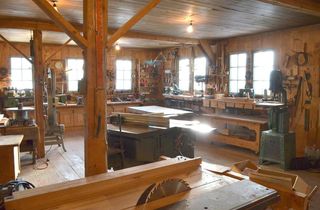 Touring dad's shop (2013)
Touring dad's shop (2013)